|
|
|
|
|
|
|
posted July 8, 1997 Moving Stars and Shifting Sands of Presolar History Written by Donald D. Clayton Centennial Professor, Department of Physics and Astronomy Clemson University, Clemson, SC |
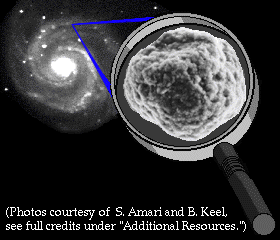 |
Hands-on Astronomy
Study of presolar grains has become an interdisciplinary field, creating a kind of hands-on astronomy that involves meteorite researchers, astronomers, astrophysicists, chemists, and mineralogists. The field blossomed in 1987 when John Wacker and Tang Ming, working in the laboratory of Edward Anders at the University of Chicago, discovered minuscule diamonds, only a few nanometers across, from a type of meteorite called carbonaceous chondrites. To do so, 99.9% of the meteorite specimen must be dissolved, leaving behind a resistant residue. (Anders has noted that the process is like burning down a haystack to find the needle!)
| SEM micrograph of presolar graphite grain, 5 micrometers in diameter, from the Murchison meteorite [Data link from Meteoritical Database]. Its surface texture resembles an onion. Photo courtesy of S. Amari, Washington University, St. Louis. | 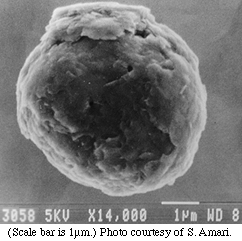 |
The Special Case of Silicon Carbide
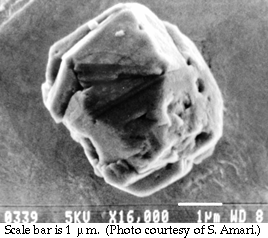 |
Scanning electron microscope (SEM) micrograph of a 4 micrometer presolar SiC crystal from the Murchison meteorite. |
As these data mounted, however, a great puzzle emerged. The number of excess 29Si atoms varies from grain to grain, but it is always 2.2 times greater than the number of excess 30Si atoms in the same grain (in comparison with normal silicon). When plotted on a graph of excess 29Si atoms versus excess 30Si atoms, each grain is a single point; but those points line up in almost a straight line. Moreover, most of the presolar particles defining that line have more 29Si and 30Si than has the Solar System. Both facts are puzzling. That line has been called "the mainstream" of SiC particles by the meteorite researchers that first defined it by their experimental measurements.
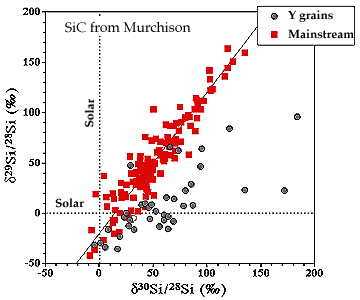 |
Ratios of silicon isotopes in presolar grains from the Murchison carbonaceous chondrite. Mainstream particles are the most abundant SiC grains. Y grains are a rare (1%) subgroup, but are not important to the story told here. (Courtesy of Ernst Zinner, in whose laboratory the data were obtained.) Silicon isotopic data can also be imaged in an ion microprobe. |
In 1988 I published an Astrophysical Journal paper in which I offered a possible explanation of the alignment of these data points. Using the theory that explains the growth of the heavy element abundances in the Milky Way Galaxy with time (observed by astronomers) as being a consequence of nucleosynthesis (element formation) in the stars, I argued that the interstellar abundance of silicon should increase in such a way that the number of 29Si and 30Si atoms should grow more rapidly than the number of more abundant 28Si atoms and that, furthermore, the excesses would align along a slope very similar to that observed. This idea helped to establish a theory for the formation of these particles; namely, that they were created within the streams of matter leaving the surfaces of red giant stars called "carbon stars" by astronomers. Their dust grains inherited the initial interstellar Si isotopes from which the stars were born. That idea was also suggested by the discoverers of those particles. These heavy elements have had their isotopes changed by the star in a predictable way that is well understood. The excess heavy element isotopes are called " s process isotopes" by nuclear astrophysicists.
So far so good. For almost a decade this picture has grown in assurance. It faced, however, a growing problem and concern. How can presolar stars have more 29Si and 30Si than the Sun when they have, by definition, formed and lived their lives prior to the birth of the Sun? The theory led one to expect that presolar stars should have less 29Si and 30Si than the Sun, not more. This problem resisted all attempts at solution, and threatened to destroy the otherwise successful theory.
Stars on the Move
My new work offers a solution that couples my earlier ideas to growing astronomical evidence that the orbits of stars in the Milky Way are altered over the life time of the Galaxy. Because the element abundances are higher in more central regions of the Galaxy, I suggest that the carbon stars were born there, rather than at the location of the Sun's birth. Being richer in elements heavier than carbon, they will also be rich in 29Si and 30Si, and samples from them would lie along the correlation line described earlier. During their approximately 2 billion year lifetimes, the orbits of these stars evolved to larger orbits, farther from the center of the Galaxy. Many would have ended their lives near the cloud from which the Solar System formed and, therefore, deposited their dust there.
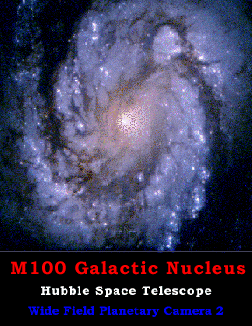 |
Stars do not have fixed locations in a galaxy. Not only do they orbit around the galactic center but they spiral outwards as well. This striking photo is of a galaxy similar to our Milky Way. (M100 Galactic Nucleus, Hubble Space Telescope, Wide Field Planetary Camera 2.) |
Astronomers have studied the effects of moving stellar orbits in two different cases. First, studies of Globular Clusters in the Galaxy (spherical assemblages of 100,000 stars held together in orbits about their own center of mass) show that the central regions shrink over time and outer regions move out to compensate. These movements result from gravity collisions that cause small stars to diffuse outward and large ones to sink inward. It is described in the famous book Galactic Dynamics by Binney and Tremaine. In the Milky Way Galaxy, which is similar to the photograph of M100 shown above, the small carbon stars diffuse outward in a similar fashion.
In the second case, Roland Wielen and his colleagues in Heidelberg, Germany published an exciting interpretation of the Sun's own excess of heavy-element abundances. They argued in terms of stellar diffusion theory that the Sun has also diffused outward from its birthplace 6600 pc from the galactic center to its present location at 8500 pc from that center. When I read their arguments I was very excited, for not only had they offered a solution to the old problem of the Sun having more heavy elements than the gas in the solar neighborhood, but they also triggered my own solution for the presolar carbon stars. They diffused outward not to the Sun's present location, but to the cloud at 6600 pc where the Sun was born.
Gravity Assist
Why would the carbon stars move to larger orbits? I think that the stars are scattered by molecular clouds in the inner regions of the Galaxy. Because of their great masses, about 100,000 times that of the Sun's mass, these clouds provide a strong gravitational force. When the carbon stars approach them, they are accelerated by the gravity field to higher velocity, placing them on orbits that reach further out. This same mechanism is used by mankind when sending spacecraft to the outer Solar System. For example, the Voyager spacecraft was allowed to approach Jupiter's strong gravity as it flew past the giant planet and its moons . Voyager picked up speed and was scattered past Jupiter to a new orbit farther out, allowing it to pass Saturn and the other outer planets. Such gravity assists have been used frequently by NASA. I suggest that gravity assists were also used by our own Milky Way Galaxy.
Astronomers are also excited by this possibility. There exist
few ways to learn of stars that existed before the Sun in the
more central portions of our Galaxy, but their STARDUST carries
the message. By carefully learning the relative abundances of
these particles, astronomers will be able to map the dynamic history
of our Milky Way. By noting that the molecular clouds are known
to be concentrated in the inner Galaxy, the numbers that scattered
outward to meet the forming Sun will exceed the number that scattered
inward by the factor ten that meteorite specialists have documented
with their meticulous cataloguing of the isotope ratios within
those particles. What an astronomical story to be read within a stone!
Editor's note: One of the leading scientists in the study of presolar grains is Dr. Ernst Zinner of Washington University in St. Louis. To honor his contributions to this and other fields of meteoritics, Ernst is the winner of the 1997 Leonard Medal of the Meteoritical Society, which will be awarded at the annual meeting of the society, July 21-25, 1997, in Wailea, Maui.
|
|
[ About PSRD |
Archive |
Search |
Subscribe ] [ Glossary | General Resources | Comments | Top of page ] |